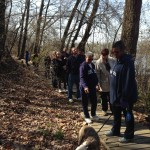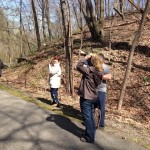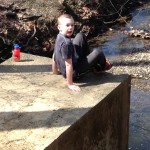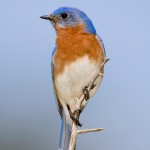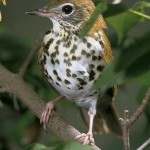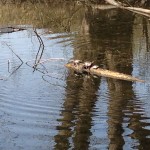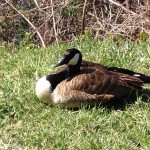
- Walking along Wildwood
- Looking for birds.
- Taking a break.
It was a lovely day for a hike, especially one for scouting birds. Our goal was to locate the migrating Red Winged Blackbirds, Bluebirds, and Wood Thrushes as they returned for breeding.
- Red Winged Blackbird
- Wood Thrush
The male Red Winged Blackbirds were everywhere. We did not see any females so they probably had yet to arrive. There were no Bluebirds evident around the bluebird houses, but we know they have arrived, since they have been viewed elsewhere. No sign of Wood Thrushes yet, but they have frequented Wildwood in past springs and summers.
- Those are turtles piled on a log,
- This Canada Goose refused to move!
- The huge sycamore!
We did see Egrets, Canada Geese, a snake, a dead raccoon that looked like it was sleeping, a Blue Jay, Red-Bellied Woodpecker, a Thrasher and many, many turtles! Then there was the huge sycamore that was estimated to be at least 100 years old!
We spent a few minutes discussing the birds we were searching for. The Red Winged Blackbird, for instance has control over its epaulet, the red feathers on its shoulders. They can hide the red and imitate another bird so as to enter another male’s territory and mate with its female. These birds are the most prevalent songbirds in North America. They can be found in wet fields, hayfields and marshes. Their diet consists mostly of vegetation, weed seeds, waste grains, mayflies, caddis flies, caterpillars, grubs, grasshoppers, berries and other fruit. Nests occur in trees, shrubs, grasses, or among cattails and rushes. Winter range is the Southern United States.
The Eastern Bluebird arrives in March and has been known to overwinter, if food is available. Bluebirds are cavity nesters, roosting close to the ground facing meadows or forest openings. They eat insects and berries. They too overwinter in the Southern United States. We spent some time discussing the bluebirds arch enemy, the House Sparrow, which was brought over from Europe. The House Sparrow is also a cavity nester, is very aggressive and will kill adult Bluebirds and their young, even building nests over the bodies! The male Bluebird, like the Red-Winged Blackbird, arrives before the female. He will pick a nesting site, put a few pieces of grass or pine needles in the cavity, and then proceed to sing his heart out flapping his wings trying to convince a female that his is the best homestead. The female will choose the cavity that suits her desires best.
The Wood Thrush is an elusive brown bird with brown spots on its chest and dwells in deciduous forests near streams. They prefer larger tracts of land that are not fragmented, but have been known to nest in gardens and parks, although their nesting success rate is poor in these areas due to predators like the Cowbird, Raccoon, Possum, and cat. Wood Thrush numbers have been declining rapidly due to loss of habitat and acid rain. They need ten to fifteen more times the amount of calcium needed by other birds. The acid rain is killing off the invertebrates that the Wood Thrush depends on for calcium, like the snail. Nests are usually in the crotch of a tree six to twelve feet from the ground. The male arrives first and when the female comes he will do most of the feeding while the female fools around with other males! The Wood Thrush has a beautiful melodic song. It actually harmonizes with itself singing two notes at the same time. The Wood Thrush arrives late April and leaves in mid August to travel all the way to Central and South America.
If you have never been to Wildwood Park it comes highly recommended. You never know what wildlife you will see. It is full of surprises!

